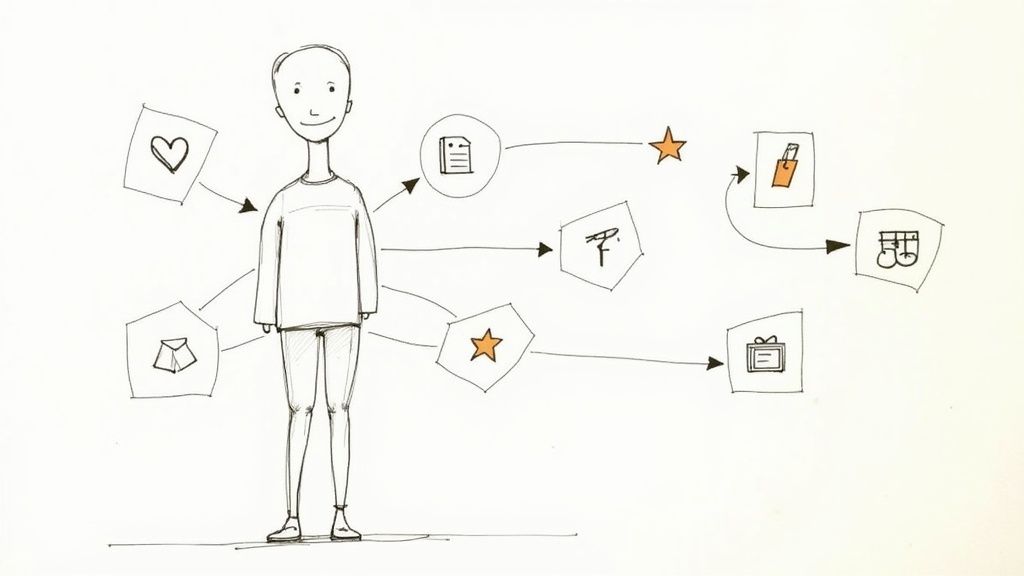Your old SEO playbook is obsolete.
You're not just trying to rank on Google anymore. A growing portion of your audience now asks ChatGPT, Perplexity, and Gemini for product recommendations.
The real problem isn't getting clicks; it's getting your product cited and recommended by large language models. If your product information isn't structured for machine readability, you simply don't exist in these new discovery channels. You are invisible to a huge segment of potential customers.
This is where the best AI optimization for making products more visible becomes critical. For SaaS marketing teams and SEO managers, the goal has shifted from keyword ranking to becoming a definitive source for AI-generated answers. Ignoring this means your competitors, who are adapting, will be the ones recommended.
This guide bypasses generic advice. It provides ten specific, field-tested AI strategies that address both traditional search and the new world of AI-driven discovery.
You will learn how to:
- Optimize product data for both human and machine consumption.
- Automate visibility across search engines, LLMs, and advertising platforms.
- Ensure your products are seen, recommended, and purchased in an AI-first world.
1. AI-Powered SEO: Go Beyond Keywords
AI-powered SEO uses machine learning to dissect search patterns, competitor strategies, and SERP dynamics. It's not about stuffing keywords. It's about identifying high-opportunity topics that balance search volume with achievable ranking difficulty. The goal is to align your product pages with the precise signals that search engines—and now, answer engines—prioritize.
This method is one of the best AI optimization for making products more visible because it forecasts what matters for ranking.
For instance, an e-commerce brand used Semrush to analyze top pages for "sustainable running shoes." The AI revealed that leading articles averaged 1,500 words, included a video, and frequently discussed material sourcing. This insight provided a clear content roadmap, not just a list of keywords.
Actionable Implementation
- Focus on Semantic Relevance: Use AI to find topic clusters, not just keywords. Building authority around "AI-driven analytics" helps you rank for a wider range of related queries.
- Combine AI with Human Insight: Treat AI recommendations as a starting point. Your team’s expertise adds the unique perspective algorithms can't replicate.
- Monitor SERP Volatility: Use AI-driven rank tracking, like Moz offers, to get alerts on ranking shifts. This enables rapid adaptation to algorithm updates.
This approach is ideal for scaling content and outmaneuvering competitors in crowded markets.
2. Dynamic Pricing AI: Win the Buy Box
Dynamic pricing AI uses machine learning to adjust prices and offers in real time. The algorithms analyze competitor pricing, inventory levels, and customer demand signals. This allows you to find the optimal price point that maximizes conversions without destroying profit margins.
This is a critical AI optimization for making products more visible because it makes your offer more competitive at the exact moment a customer is ready to buy.
For example, an online retailer using a tool like Competera can automatically lower the price of a popular sneaker when a key competitor runs out of stock. This move captures immediate market share. Airlines have done this for years with yield management, adjusting ticket prices based on booking velocity.
Actionable Implementation
- Establish Clear Price Bands: Set firm minimum and maximum prices. This prevents extreme fluctuations that could damage brand perception.
- Communicate Value, Not Just Price: Use AI-driven promotions to highlight the why. Instead of a simple discount, the system might trigger a "free shipping" offer for a customer segment that is highly responsive to it.
- Monitor Competitor Reactions: Implement AI that tracks competitor prices and predicts their responses to your adjustments, allowing for a more proactive strategy.
This is best for businesses in competitive markets with fluctuating demand, like retail and travel.
3. Personalization Engines: Create Unique Discovery Paths
Personalization engines use machine learning to analyze user behavior, purchase history, and real-time interactions. Instead of a one-size-fits-all storefront, the AI proactively surfaces items an individual is highly likely to purchase.

This strategy is one of the best AI optimization for making products more visible because it creates countless unique discovery paths for your catalog.
Think of how Netflix's algorithm presents a different homepage to every user. Or how Amazon’s "Frequently bought together" feature increases the visibility of complementary products at the point of conversion. A 2021 McKinsey report found that 71% of consumers expect personalization. These systems ensure the right product finds the right customer.
Actionable Implementation
- Balance Personalization with Serendipity: Use some recommendation slots to show new or unexpected items. This prevents filter bubbles and helps users discover new product categories.
- Implement Robust Data Privacy: Be transparent about the data you collect and how it's used. Trust is essential for users to feel comfortable.
- A/B Test Recommendation Logic: Continuously test different algorithms. For example, test a "trending" module against a "recommended for you" module to see which drives more engagement.
This is ideal for e-commerce stores with large catalogs or subscription services aiming to increase retention.
4. Visual Search AI: Let Images Do the Talking
Visual search AI shifts product discovery from text to image analysis. Using deep learning, this tech allows consumers to find products by using a picture. AI algorithms recognize objects, styles, and colors within an image to surface visually similar items from a product catalog.

This method taps into the powerful human preference for visual information. Platforms like Pinterest Lens and Google Lens let users point their camera at furniture and instantly find similar items online. ASOS uses its Style Match feature to let shoppers upload a photo of an outfit and get recommendations for comparable products on their site.
Actionable Implementation
- Prioritize High-Quality Imagery: Use high-resolution photos from multiple angles against clean backgrounds. This gives the AI clear data to analyze.
- Optimize Image Metadata: Use descriptive alt text and file names with relevant keywords. This metadata helps search engines index the image content.
- Test with Visual-First User Segments: Engage with customers who prefer platforms like Pinterest or Instagram. Gather feedback on your visual search functionality to refine its accuracy.
This is a must for fashion, home decor, and retail, where a product's appearance is its primary selling point.
5. Content Generation AI: Scale Your Descriptions
Content generation AI uses large language models to automate the creation of product-centric text. You feed the AI detailed product specifications to produce optimized titles, descriptions, and marketing copy at scale.
This is arguably the best AI optimization for making products more visible because it directly addresses content velocity and quality.
An e-commerce store with thousands of SKUs can use a tool like Jasper AI to instantly generate unique, SEO-friendly descriptions for each item, avoiding duplicate content penalties. This ability to rapidly create and refine content is crucial for visibility. Many teams now power generative AI for content creation to handle these tasks efficiently.
Actionable Implementation
- Provide Detailed Briefs: Give the AI specific inputs: keywords, target audience pain points, and tone of voice. Vague prompts lead to generic copy.
- Human-in-the-Loop Editing: Always treat AI-generated text as a first draft. A human must review for brand alignment and factual accuracy.
- Optimize for Different Channels: Use AI to adapt a core message for various platforms. A detailed website description can be quickly repurposed into a punchy version for social media ads.
This is ideal for large online retailers or marketing agencies needing to produce high volumes of content quickly.
6. Programmatic Advertising AI: Automate Ad Bidding
Programmatic advertising AI automates buying digital ad space. Machine learning algorithms analyze user data, predict conversion likelihood, and adjust bids in real-time auctions. The AI allocates budget to the highest-performing channels, audiences, and creative elements.
This method is a top-tier AI optimization for making products more visible because it shows your ads to the most relevant users at the right moment.
For example, a retailer using Google's Performance Max can set a target cost-per-acquisition (CPA). The AI then automatically manages bids across Search, Display, and YouTube to reach users most likely to purchase within that budget. This is far too complex for manual oversight.
Actionable Implementation
- Set Clear Conversion Goals: Your AI needs a clear objective, like "add to cart" or "purchase." Ensure your tracking is accurate.
- Test Audience Segments: Feed the AI distinct audience signals. You might find your "in-market for electronics" segment converts better on weekends, an insight the AI can use to adjust bidding.
- Refresh Creative Assets Regularly: Combat ad fatigue by providing the AI with a steady stream of new images, videos, and ad copy to test.
This is perfect for businesses scaling advertising efforts across multiple platforms.
7. Sentiment Analysis AI: Listen to Your Customers
Sentiment analysis uses natural language processing (NLP) to interpret emotions in customer reviews, social media comments, and support tickets. These algorithms classify text as positive, negative, or neutral, providing a real-time pulse on public perception.
This method translates unstructured feedback into actionable marketing insights.
A software company using a tool like Brandwatch might detect growing negative sentiment around a new feature's UI. This data allows marketing to create help guides and gives the product team clear feedback for updates. It also helps identify features customers love, which can be highlighted in campaigns.
Actionable Implementation
- Combine Automated Analysis with Human Review: Use AI to flag sentiment shifts, but have your team dig into the context. Sarcasm requires human interpretation.
- Monitor Competitor Sentiment: Benchmark your product’s perception against competitors. If a rival sees negative feedback after a price change, it creates a strategic opening for you.
- Use Customer Language in Marketing: Identify positive phrases customers use in reviews and incorporate them into your product descriptions and ad copy.
This is for brands that need to manage their online reputation and use customer voice to guide marketing.
8. Inventory Forecasting AI: Never Go Out of Stock
Inventory forecasting AI uses predictive analytics to anticipate customer demand and manage stock levels. By analyzing historical sales data, market trends, and external factors, these systems ensure products are available when and where customers want them.
This is one of the best AI optimization for making products more visible because availability is a primary ranking factor in most online retail algorithms. A stockout causes your product listing to be delisted or deprioritized.
Amazon’s A9 algorithm favors products that are in stock and available for quick shipping. Zara uses sophisticated AI to match store inventory with local demand, ensuring popular items are always on the shelf.
Actionable Implementation
- Integrate External Data Signals: Feed your AI models with external data like local events, weather forecasts, and social media trends. A heatwave can predict a surge in demand for air conditioners.
- Segment Your Forecasting: Apply different AI models to different product categories. Fast-moving goods require a different approach than seasonal luxury items.
- Retrain Models Regularly: Continuously feed new sales and market data back into your system to keep forecasts accurate.
This is crucial for retailers and e-commerce businesses where availability directly impacts sales and search placement.
9. Conversational AI: Guide Product Discovery
Conversational AI transforms passive website browsing into an active, guided discovery process. These systems engage visitors in natural language, understanding user intent to answer questions and offer personalized product recommendations.
This is one of the best AI optimization for making products more visible because it creates a direct, personalized sales channel on your site.
For example, Sephora's virtual beauty assistant asks users about their skin type to recommend specific makeup products. This interaction exposes customers to products they might have otherwise missed. To understand the foundational tech, you can learn more about what is conversational AI.
Actionable Implementation
- Design Human-Centric Conversation Flows: Map out conversational paths that mimic a helpful sales associate. Start broad and narrow down to specific needs.
- Integrate Directly with Your Product Database: Ensure your chatbot can pull real-time information on stock, pricing, and reviews to provide accurate answers.
- Provide a Clear Path to Human Agents: Design a seamless escalation for complex queries. An easy "talk to a human" option prevents a poor customer experience.
This is highly effective for sites with large catalogs or complex product offerings.
10. Attribution Modeling AI: Know What Really Works
Attribution modeling with AI moves beyond simplistic last-click analysis. It uses machine learning to process multi-touch data points, accurately assigning credit to the various marketing channels that influence a purchase.
This is a powerful AI optimization for making products more visible because it provides a clear, data-backed view of marketing ROI.
A D2C brand using Google Analytics 4's AI-driven attribution might discover that while paid search closes sales, initial product discovery happens most often through organic social media. This insight allows them to reallocate budget to top-of-funnel awareness campaigns that were previously undervalued.
Actionable Implementation
- Combine Multiple Attribution Models: Use AI to compare last-click, first-click, and data-driven models to get a holistic view of your customer journey.
- Test Incrementality Regularly: Use AI-powered lift studies to confirm whether a channel is genuinely driving incremental visibility or just capturing existing demand.
- Adapt to Privacy Changes: Prioritize first-party data. Feed this high-quality data into your AI attribution tools like Singular or Branch to maintain model accuracy.
This is ideal for businesses with multi-channel marketing strategies that need to optimize budget allocation.
Comparing the Top 10 AI Product Visibility Methods
| Method | 🔄 Complexity | ⚡ Resources Needed | 📊 Expected Outcomes | 💡 Ideal Use Case | ⭐ Key Advantage |
|---|---|---|---|---|---|
| AI-Powered SEO | Medium | Moderate | Increased organic traffic, better rankings | Content-heavy sites, competitive SERPs | Data-driven keyword targeting |
| Dynamic Pricing AI | High | High | Higher revenue & margins | Retail, travel, marketplaces | Maximizes margin via automated pricing |
| Personalization Engine AI | High | High | Increased CTR, conversions & LTV | Marketplaces, streaming services | Improves relevance and cross-sells |
| Visual Search AI | High | High | Better discovery for visual products | Fashion, furniture, home goods | Enables image-driven product discovery |
| Content Generation AI | Low–Medium | Low–Moderate | Scales content creation, faster publishing | Large catalogs, multilingual sites | Rapid, consistent SEO-friendly copy |
| Programmatic Advertising AI | Medium–High | High | Improved ROAS, better targeting | Performance marketing campaigns | Automates bids and budget allocation |
| Sentiment Analysis AI | Medium | Moderate | Actionable product insights | Brand monitoring, product improvement | Extracts trends from customer feedback |
| Inventory Forecasting AI | High | High | Fewer stockouts, better availability | Retail, omnichannel businesses | Balances inventory to boost availability |
| Conversational AI | Medium | Moderate | 24/7 assistance, higher engagement | Guided selling, customer support | Real-time personalized guidance |
| Attribution Modeling AI | High | High | Better budget allocation, more efficiency | Multi-channel advertisers | Quantifies channel contributions |
Stop Chasing Clicks. Start Winning Citations.
The old model was about chasing clicks and climbing SERPs.
The new imperative is to win citations and become a trusted source for AI-driven answers.
Your product isn’t just competing on a webpage anymore. It’s competing for a mention in an LLM’s response, a recommendation in a personalization engine, and a place in an AI-curated shopping guide. The core takeaway is this: you must see AI visibility as the new foundation connecting all your marketing efforts.
Your First Actionable Steps
Don't try to implement all ten strategies by next quarter. Start smart. Choose one area that aligns with your most pressing business challenge.
- Is customer churn a problem? Start with Sentiment Analysis AI (#7) to understand the "why" behind user behavior.
- Struggling with low conversion rates? Focus on a Personalization Engine (#3) to deliver hyper-relevant product recommendations.
- Losing to competitors on price? Implement Dynamic Pricing AI (#2) to stay agile without sacrificing margin.
The most universal starting point is understanding your current AI footprint. You cannot optimize what you do not measure. Find out which questions your customers are asking AI assistants and see which competitors are getting cited as the answer.
Once you establish that baseline, you can build a focused, data-backed strategy. The future of product visibility won't be won by the brand with the most backlinks, but by the one that becomes the most reliable source of information for AI.
Ready to see exactly where your brand stands in the new AI-powered search landscape? AI SEO Tracker provides the critical data you need, showing you which LLMs are citing your content and where your competitors are winning. Stop guessing and start building a data-driven strategy to dominate AI-generated answers by signing up for a free audit at AI SEO Tracker today.

